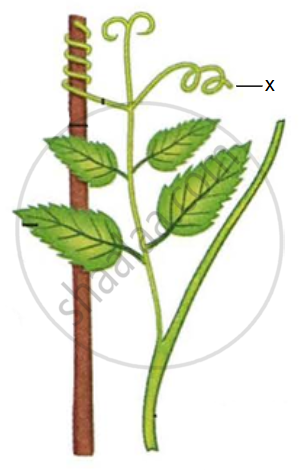Advertisements
Advertisements
प्रश्न
To which of the following directional stimulus roots of a plant do not respond?
पर्याय
moisture
candle light
touch
gravity
उत्तर
touch
Explanation:
Roots do not respond to touch.
APPEARS IN
संबंधित प्रश्न
Give one example of chemotropism. State whether this example is of positive chemotropism or negative chemotropism.
Name the plant organ which is positively geotropic
Which of the following is not caused by a growth movement?
While conducting experiments to study the effect of various stimuli on the plants, it was observed that the roots of a plant X grow and bend towards two stimuli A and B but bend away from a third stimulus C. The stem of the plant X, however, bends away from stimuli A and B but bends towards the stimulus C. The stimulus B is known to act on the roots due to too much weight of the earth. Keeping these points in mind, answer the following question:
- What could stimulus A be?
- Name the stimulus B.
- What could stimulus C be?
- The branches of a fallen tree in a forest grow straight up in response to two stimuli. What could be these two stimuli out of A, B and C? Also name these two stimuli.
A potted plant having straight parts A and B was placed horizontally on its side as shown in Figure (i). After a few days, it was observed that parts A and B of the plant acquired new positions as shown in Figure (ii).
- Name the phenomenon exhibited by the position of plant parts A and B in Figure (ii).
- Name the stimulus (other than sunlight) which causes plant part A to grow and bend upwards, and plant part B to bend downwards.

Name the part of plant which shows positive geotropism. Why?
Higher Order Thinking Skill.
There are 3 plants A, B and C. The flowers of A open their petals in bright light during the day but closes when it gets dark at night. On the other hand, the flowers of plant B open their petals at night but closes during the day when there is bright light. The leaves of plant C fold up and droop when touched with fingers or any other solid object.
- Name the phenomenon shown by the flowers of plant A and B.
- Name one plant each which behaves like the flowers of plant A and B.
- Name the phenomenon exhibited by the leaves of plant C.
- Name the plant which behaves like the leaves of plant 'C'?
While conducting experiments to study the effects of various stimuli on the plants, it was observed that the roots of plant X grow and bend towards two stimuli A and B but bend away from a third stimulus C. The stem of the plant X however bends ” away from stimulus A and B but bends towards the stimulus C. The stimulus B is known to act on the roots due to factors related to Earth. Keeping these points in mind, answer the following questions:
- What could be stimulus A?
- Name the stimulus seen in B.
- What could be stimulus-C?
Name the phenomenon occurring in plants which are under the control of gravity, water and chemicals with one example each that shows the movement involved.
Ali has some pea plants in his garden which need a support to grow as seen in the picture given below:

- Name the phenomenon depicted by the shoot in the given figure.
- Define the above phenomenon.
- Write the name of the part marked X.
